- Home
- Autobias control
- Modules adaptive bias control
- Modules for to optimize bias with an supply of bias AB-D
Module AB-D for 2 tubes, PP & PPP & Single Ended amps, requires 6.3VAC & bias supply from the amps circuit. Not suitable where the 6.3VAC filament supply is referenced to ground, use the ABF-Q below.
Automatic opimize bias control AB-D
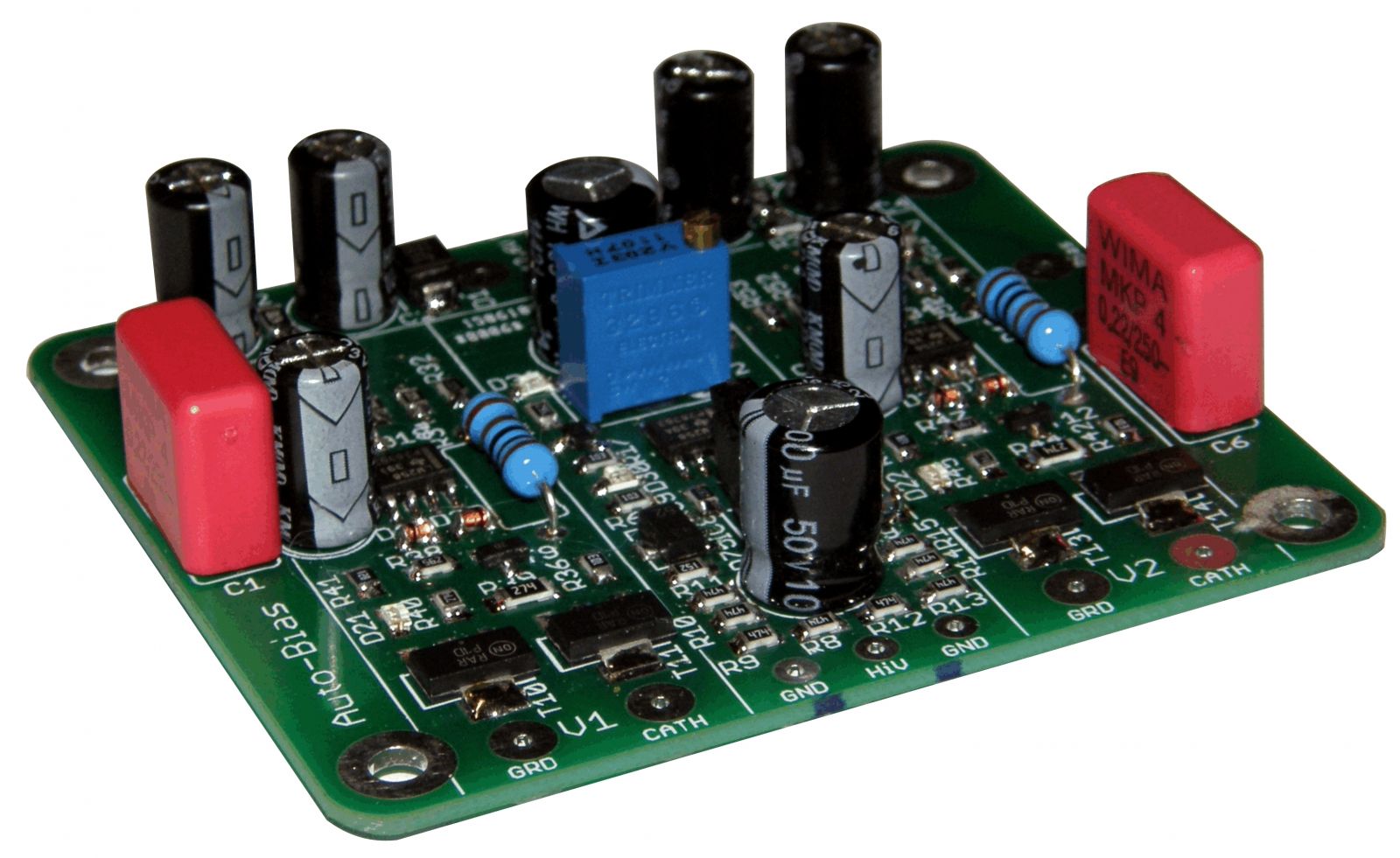

| Manufacturer: | TES |
| Price : | 56,00 € |
| Availability: | In stock |
DC current saturates an output transformer which results in increased low frequency distortions.
For that scenario, use the auto bias module models ABF-Q or ABS-Q+ or provide your own small power transformer of around 2VA with, for example, a 9V secondary.
- Suitable for single ended amps
- power supply requirement is 6.3 to 12VAC
- negative DC bias supply between -70V to -120V
INSTALLATION AND USER MANUAL FOR THE AB-D MODULE
Introduction:
This module has been designed to maintain a constant bias voltage through all power output tubes for your tube stereo power amp.
The bias is kept at a constant level on the output tubes, irrespective of the signal level.
Benefits:
The advantage of using the AB-D module is that it will extend output tube life, in a lot of cases it will also improve the sound and last but not least, you will never have to worry about adjusting the bias again.
- Instead of a pair of output tubes being biased together, now all output tubes are individually biased for greater control and stability
- No need to keep an eye on and/or adjust the bias of the output tubes
- Significant extension of the output tubes life
- Bias is not influenced by the input signal
- Suitable for Single Ended Amps
- Undistorted and improved sound for a great listening experience
- Reduction in hum and noise level of the amp
- No maintenance or additional adjustments are required after the initial setup
- Improved overall operation of the amp due to the reduction in the danger of a tube red plating
- The AB-D ensures that bias is kept at the pre-set value (see Initial Setup) even as the tubes age
- The AB-D comes with a soft start feature, which slowly brings up bias to each output tube
Quick Overview:
The AB-D module has two blue LED’s, one for each output tube, which when lit, indicate that bias is at the correct level and that all is good with each tube.
Should any of these blue LED’s go out or not go on after power up, means that here is an issue with that given output tube and that the tube in question needs to be immediately replaced.
When the amp is powered up, at first a red LED will be on, indicating that there is power to the AB-D module. The red LED will go out after about 20s.
After a further delay of between 40-50s, each of the blue LED’s should come on indicating that the bias is now set and stable for each output tube. The amp is now ready to use.
The AB-D is suitable for class A, AB and C tube amplifies.
Presetting the AB-D module bias level:
Before the AB-D module can be wired up, you need to preset its bias voltage.
As an example, for EL34 tubes, we recommend a bias voltage of 425mA, for KT88 tubes we recommend 450mV. You will need to consult the tube specifications in order to determine the optimal bias voltage for the tube in your amp.
This bias level is set using the blue colored trimmer on the AB-D module.
We strongly recommend that you preset the AB-D module before you proceed with installing it into your tube amp!
We need to connect a 6.3VAC supply to the AB-D module for the bias preset. If you have a spare transformer with a 6.3V winding, use that, if not, you may need to ‘borrow’ 6.3VAC from your tube amp.
If you have a spare transformer, wire it up and connect the 6.3VAC winding to the two 6,3 AC pads on the AB-D module.
If you need to ‘borrow’ your amp, we recommend that you remove ALL tubes, including the rectifier tube, as we do not need any high voltage B+
BE CAREFUL, even though all tubes are removed, there will still be high voltage AC present at the rectifier tube socket!
Connect two wires, 6.3VAC to 12VAC to the 6,3 AC pads on your AB-D module.
Place your AB-D module on a non-conductive surface. Now switch on your amp or power up your 6.3VAC transformer and you should see the red LED on the AB-D module light up. This LED will go out after about 20s.
Set your meter to read DC and to the lowest scale, say 1V, 2V or 5V. Put the black meter lead on any GND pad on the AB-D module and put the red meter lead on the pad next to electrolytic capacitor, see below. Now adjust the blue trimmer until the desired bias level is achieved.
That’s it, you just set the AB-D module to the desired bias operating level.
Example:
PP stage 2 x EL34, class AB1, ultra linear:
To set the bias for an EL34 tube, the recommended anode current for AB1 class is 42.5 mA. We therefore set the bias at 425 mV (0.425 V).
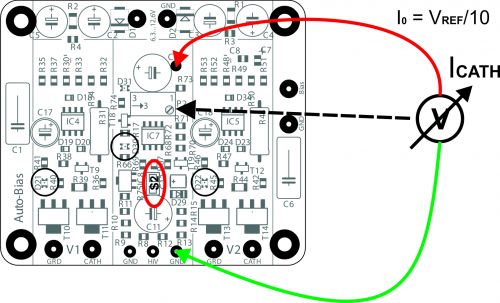
Disconnect the spare transformer or power down your amp, wait for half a minute or so and disconnect the wires from the 6,3 AC pads on the AB-D module.
DO NOT EVER readjust the trimmer once the AB-D module is installed and wired up. The whole idea is to set in ONCE and forget!
Installing and wiring the AB-D module into your tube amp:
Please refer to the drawing below, which shows a typical tube amps connection for your AB-D module.
The HiV input is only connected if the amplifier is equipped with a delayed connection anode voltage and connection with a time of more than 20 seconds.
In this case the jumper S2 must be disconnected (remove jumper see fig.) !
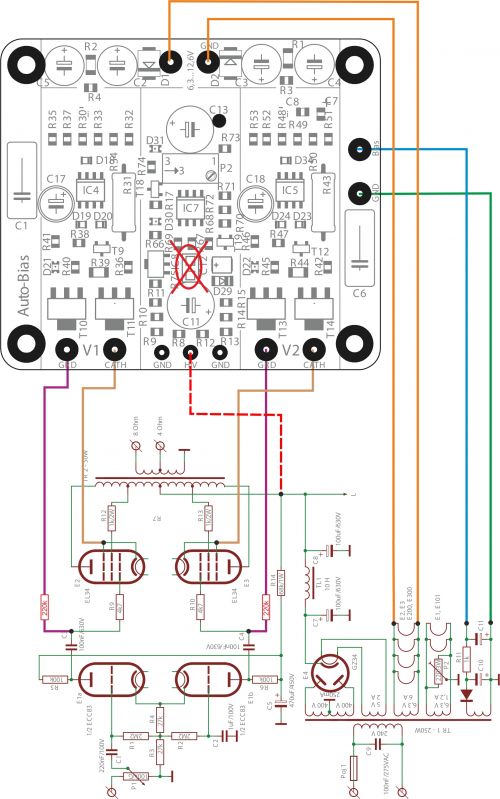
Use this diagram as a reference to the wiring of the AB-D module into your amp.
The circuits of the first grids of the output tubes must be equipped with isolation resistors (marked red with the value 100-220k).
This diagram shows a typical connection for a Single Ended Amp.
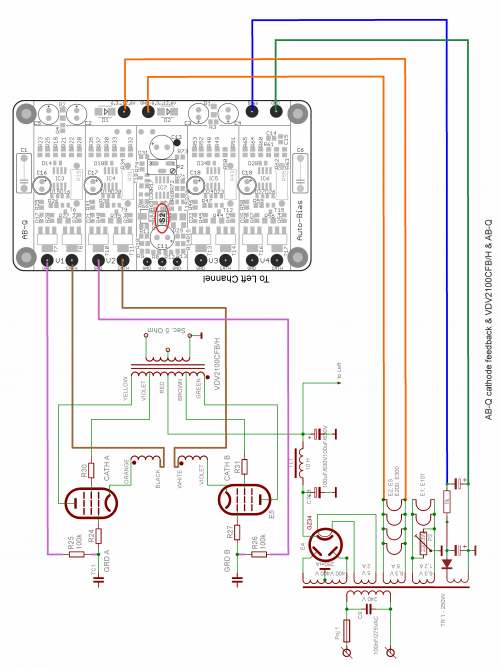
- Connect your amps -ve bias supply to the BIAS pad on the AB-D, shown as a blue wire in the above drawing
- Connect a wire from your amps star ground to the GND pad on the AB-D, shown as a green wire in the above drawing
- Connect two wires, 6.3V to 12VAC to the two 6,3….12V pads on the AB-D module, shown as orange wires in the above drawing
IMPORTANT NOTE about the 6.3V to 12VAC supply:
All auto bias modules without built in transformers WILL NOT WORK if the filament supply in your amp is in any way referenced to ground, such as a center tap! This important point is clearly explained on our web site!
If your amps filament supply is indeed referenced to ground, you MUST use a separate small power transformer for this AB-D module, around 2VA, with a suitable secondary supply, anything from 6VAC to 12VAC, or use the ABF-Q module instead which has its own on-board power transformer!
- Connect each of the two CATH pads on the AB-Q module to the CATHODE of each relevant tube, shown as brown wires in the above drawing. With almost most power tubes, this is pin 8. We also recommend that you connect the cathode of your tube, if it is a pentode, to the Suppressor grid, with most power tubes this is pin 1
- You MUST connect an isolation resistor, value between 100K to 220K, between each GRD pad on the AB-D module and the OUTPUT end of the output coupling capacitor of your amps circuit, shown as purple wires in the above diagram
- There is a jumper link on the AB-D module, shown as S2 in the above diagram. If your tube amp DOES NOT have a startup time delay, leave jumper S2 and DO NOT connect B+ to the HIV pad on the AB-D module, shown as a red wire in the above diagram.
If your tube amp has a startup time delay in excess of the AB-D soft start time, ie more than 20s, REMOVE jumper S2 and CONNECT speaker B+ to the HIV pad on the AB-D module!
This now pretty much completes the wiring of the AB-D module into your tube amp.
Double check all the wiring steps again, even triple check them 
Once you are confident that all your wiring is correct and as per the above steps, it is time to test your AB-Q module installation.
Plug in all tubes, that is the driver tubes, power tubes and the tube rectifier. In order to see the blue LED’s on the AB-D module, place your amp on its side.
Maybe stick a piece of styrofoam under one of the output transformers to cradle the amp chassis so that the tubes do not touch the bench top.
Connect an 8 or 4 OHM dummy load or your speaker.
Power up your amp. The red LED on the AB-D module should come on straight away and will go out after about 20s.
After an additional 40 to 50s, each of the blue LED’s on the AB-D module should start to come on, which indicates that each output tube has reached the preset bias level and all is good. Excellent!
You can measure the actual bias voltage on each output tube with a meter just to double check.
Set your volt meter to the 1V, 2V or 5V scale in DC volts. Put the red meter lead on the cathode pin of the tube socket and place the black meter to the chassis star ground tag. The meter should read close to your preset bias voltage. This reading might be a little higher to start with and will get close to or exactly to the preset bias voltage as the output tubes warm up.
Do this measurement for each output tube.
Leave the amp running for about 10 minutes, all four of the blue LED’s should remain lit.
Power down the amp and let everything cool down a bit. Remove dummy load, if that’s what you used, or disconnect your speaker.
Re assemble your amp and place it in its spot.
Power up your amp and after about 60s or so, the amp is ready!
LED indication
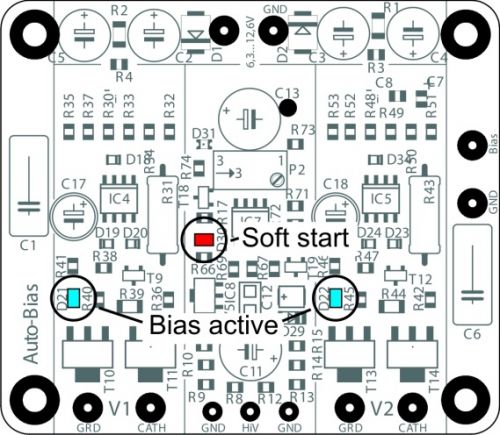
If things do not work as they are supposed to:
If the red LED on the AB-D module does not come on immediately after the amp is powered up, power it back down and check the wiring/connections two 6,3 AC pads on the AB-D module. Make sure all is good there!
If none of the blue LED’s come on after the 40-50s soft start delay, power the amp back down. Check all your wiring from the AB-D module to your amp.
If say only one of the blue LED’s come on after the soft start delay, power the amp back down and check the wiring to that particular tube for which the blue LED did not go on for. Also check to make sure that the pins in that tube socket are nice and tight and that the tube fits into the socket not at all loose. Also check the pins in the tube socket of any oxidization, if they are dirty, perhaps use Deoxit or similar to clean the pins!
Do’s and don’ts:
Do check that the pins in each tube socket are tight and that each tube does not fit loosely in the socket.
Do check that the pins in each tube socket are clean of oxidization, use Deoxit or similar if they are not clean.
Good fitting and clean pins in tube sockets make ALL the difference!!
Don’t do a lot of tube rolling! This is a sure way to loosen up the pins in your sockets! If you cannot help yourself and you must do tube rolling, check the tightness of the pins each time you swap tubes!
Table of resistance values of the resistor when replacing the trimmer on the AB module with a fixed resistor:
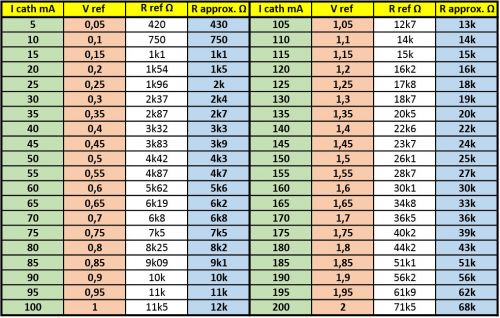
Goods of the same category - Module AB-D for 2 tubes, PP & PPP & Single Ended amps, requires 6.3VAC & bias supply from the amps circuit. Not suitable where the 6.3VAC filament supply is referenced to ground, use the ABF-Q below.
Automatic optimize bias control module for four triode output stages or four pentode push-pull (PP) amplifiers INSTALLATION AND USER MANUAL FOR THE AB-Q-ST70-ST120 AUTO BIAS MODULE Download the PDF version Introduction: This module has been designed ...
Automatic optimize bias control module for four triode output stages or four pentode push-pull (PP) amplifiers. The model AB-D-MKIII auto bias module is designed to fit the Dynaco MKIII amp chassis. It optimizes the bias for two triode or pentode ...
Automatic optimize bias control module for four triode output stages or four pentode push-pull (PP) amplifiers with isolation transformer. The model AB-Di-MKIV MKIII auto bias module is designed to fit the Dynaco MKIV MKIII amp chassis. It optimizes ...
Automatic optimize bias control module for four triode output stages or four pentode push-pull (PP) amplifiers INSTALLATION AND USER MANUAL FOR THE AB-Qi-ST70-ST120 AUTO BIAS MODULE Download the PDF version Introduction: This module has been ...
Automatic optimize bias control module for four triode output stages or four pentode push-pull (PP) amplifiers, 123x50x18 mm (5,1"x2.1"x 0.7"). The model AB-Qi auto bias module is designed to optimize the bias for four triode or pentode output tubes ...
Automatic optimize bias control module for four triode output stages or four pentode push-pull (PP) amplifiers, 100 x 57 mm. Modules for to optimize bias for four triode or pentode output stages output stages push-pull (PP) amplifiers Designed for ...
Automatic optimize bias control module for two triode output stages or four pentode push-pull (PP) amplifiers, 88 x 50 mm. The model AB-Di auto bias module is designed to optimize the bias for two triode or pentode output tubes in Push-Push (PP) or ...
Automatic optimize bias control module for four triode output stages or four pentode push-pull (PP) amplifiers. INATALLATION AND USER MANUAL FOR THE AB-Qi-M125 AUTO BIAS MODULE Download the PDF version Introduction: This module has been designed to ...
Automatic optimize bias control module for eight triode output stages or eight pentode push-pull (PP) amplifiers, 100 x 57 mm. The model AB-Oi auto bias module is designed to optimize the bias for eight triode or pentode output tubes in Push-Push ...